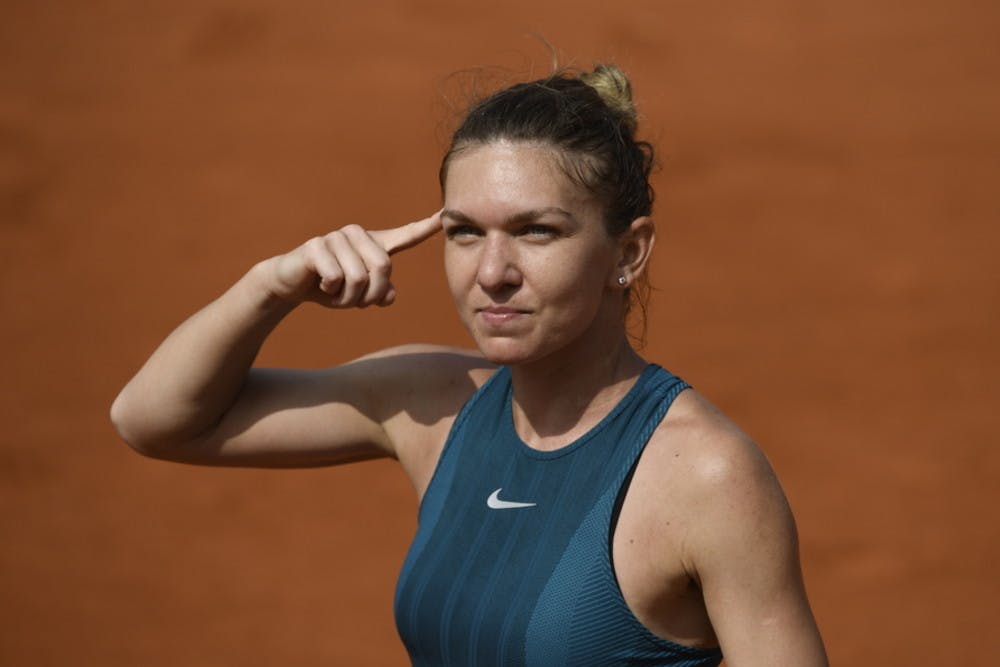The clouds had gathered over Stade Roland-Garros ahead of Simona Halep's quarter-final showdown with Angelique Kerber, but Court Suzanne-Lenglen was bathed in sunshine by the time the world No.1 had booked her place in a third Roland-Garros semi-final.
Headstrong Halep turns tables on Kerber
The world No.1 hits back after losing the opening set to reach her third Roland-Garros semi-final.

It was a fitting atmosphere for a match that began with Halep under a cloud before her effervescent swagger broke through, turning the match on its head to prevail 6-7(2) 6-3 6-2 and set up a semi-final clash with Garbine Muguruza.
"It's always a tough match when I play against her," said Halep, who now owns a 6-4 record against the German. "It's always three hours, so I'm always prepared before the match that it's going to be the same. After the first set I just stayed strong, I didn't give up at all.
"I missed a lot at the beginning of the match. She's always putting the ball back and she doesn't miss, so I tried to do too much and it didn't work. Then I changed my tactics a little bit, and it worked very well in the end."
“Of course, it's a different match [against Muguruza]. I have to expect some hard points, power. It doesn't matter who she is playing against, she does her game. So I have just to stay strong, to try to make her uncomfortable on court, and to try to play my game.”
For two world No.1s – one past, one present – to have reached the quarter-finals under the radar speaks volumes for the myriad storylines to have emerged from the women’s singles tournament, as well as their no-nonsense progress. Kerber had not dropped a set en route to the last eight, while Halep, having dropped her opening set of the tournament to Alison Riske, had given up a total of just 14 games ahead of Wednesday’s showdown.
There’s no escaping the spotlight from here on out, however. This was their third Grand Slam showdown; Kerber had edged a tight straight-sets win en route to the final at Wimbledon in 2016, while Halep’s semi-final victory at the Australian Open in January was arguably the match of the tournament, with both players on the brink of collapse after the Romanian prevailed 9-7 in the third.
That day, it was Halep who sprinted out to a 5-0 lead in just 13 minutes, but on Court Suzanne-Lenglen it was Kerber who set the tone. From the outset her forehand carried a venom that proved too much for Halep in the opening exchanges, dictating play and drawing errors to open up a 4-0 lead.
The German’s early tactics were pitch-perfect, hammering flat, punchy drives cross-court early in the rallies that kept Halep on the defensive, but the world No.1 reacted with a tactical switch of her own, rallying down the centre of the court to deny the two-time major winner an angle from which to open up the court.
Halep had racked up more than a dozen errors before getting on the scoreboard, but once she found her range Kerber found herself in a fight. The German’s double-break lead evaporated, and having twice served for the set it is to her credit that she hunkered down to clinch the ensuing tie-break.
Still, it was Halep in the ascendency. An early break in the second set meant she had won eight games out of nine either side of the tiebreak, and while Kerber pushed to restore parity, she could only applaud as the Romanian ran down a deft drop shot and dug out a winner to secure a 5-3 lead.
The set followed moments later, Kerber double-faulting to send the match into a decider.
Again Halep broke to open the set, and while Kerber hit back instantly, she could do nothing to prevent another service game slipping from her grasp. The tables had turned: having struggled to absorb the German’s aggressive start, it was Halep dictating play against an error-prone Kerber by the end of the contest. As Kerber's final backhand sailed long, Halep turned to her box and raised a finger to her temple.
The message was clear: I'm stronger, right here.
 ROLAND-GARROS
18 May - 7 June 2026
ROLAND-GARROS
18 May - 7 June 2026

